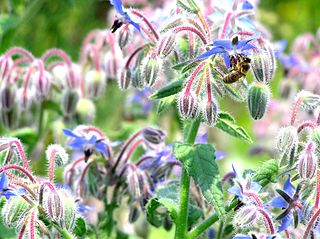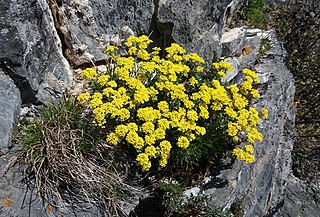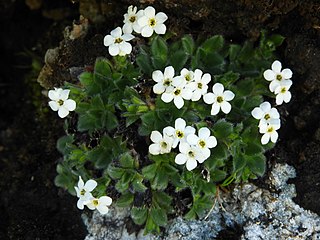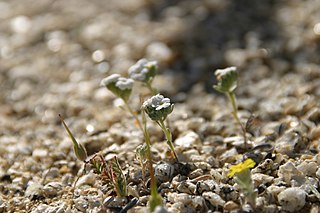
Boraginaceae, the borage or forget-me-notfamily, includes about 2,000 species of shrubs, trees and herbs in 146, to 156 genera with a worldwide distribution.

Pulmonaria (lungwort) is a genus of flowering plants in the family Boraginaceae, native to Europe and western Asia, with one species east to central Asia. According to various estimates there may be between 10 and 18 species found in the wild.

Cerinthe is a genus of flowering plants in the family Boraginaceae, known as honeyworts. The genus is characterised by a calyx made up of separate, rather than fused, sepals, a tubular corolla, and the schizocarpic fruit that divides into two parts at maturity, unlike most members of the family, where the fruit splits into four nutlets. The genus has a circum-Mediterranean distribution, ranging from the Irano-Turanian Region in the east to Morocco in the west.
Wellstedia is a genus of flowering plants traditionally included in the family Boraginaceae s.l., but placed in its own family, Wellstediaceae within the Boraginales order, by the Boraginales Working Group.

Boraginoideae is a subfamily of the plant family Boraginaceae s.s, with about 42 genera. That family is defined in a much broader sense in the Angiosperm Phylogeny Group (APG) system of classification for flowering plants. The APG has not specified any subfamilial structure within Boraginaceae s.l.

Codon is a small genus of plants from South Africa in the family Codonaceae in the order Boraginales. The genus Codon comprises two species.

Roscoea purpurea is a perennial herbaceous plant occurring in the Himalayas, particularly Nepal. Most members of the ginger family (Zingiberaceae), to which it belongs, are tropical, but species of Roscoea grow in much colder mountainous regions. It is sometimes grown as an ornamental plant in gardens.

Coldenia, named after C. Colden, is a monotypic genus of flowering plants traditionally included in the borage family, Boraginaceae sensu lato. It was assigned to the subfamily Ehretioideae, but molecular data revealed it to be more closely related to the genus Cordia, so that other authors placed in Cordioideae. Subsequently, it was placed in its own family, Coldeniaceae, within the Boraginales order, by the Boraginales Working Group.
Selkirkia is a genus of flowering plants in the family Boraginaceae. Three species occur on the South American mainland and one, Selkirkia berteroi, the first of the genus to be reported, is an endemic on Robinson Crusoe Island off the coast of Chile. It was previously considered a monotypic genus.

Glandora is a genus of flowering plants in the family Boraginaceae, native to the western and central Mediterranean region; Morocco, Algeria, Portugal, Spain, France, Italy and Greece. It was split from Lithodora in 2008.

Odontarrhena is a large genus of flowering plants in the family Brassicaceae. They were originally a separate genus and then were amalgamated into the Alyssum genus, but then morphological and molecular evidence has reseperated them. Some of the genera are nickel (Ni) hyperaccumulators.

Myosotis bryonoma is a species of flowering plant in the family Boraginaceae, endemic to the South Island of New Zealand.Heidi Meudt, Jessica Prebble and Michael Thorsen described the species. Plants of this species of forget-me-not are perennial with a creeping habit, bracteate inflorescences, and white corollas.

Myosotis retrorsa is a species of flowering plant in the family Boraginaceae, endemic to the South Island of New Zealand. Heidi Meudt, Jessica Prebble and Rowan Hindmarsh-Walls described the species. Plants of this species of forget-me-not are perennial with a prostrate habit, bracteate inflorescences, and white corollas.
Myosotis umbrosa is a species of flowering plant in the family Boraginaceae, endemic to the South Island of New Zealand. Heidi Meudt, Jessica Prebble and Michael Thorsen described the species. Plants of this species of forget-me-not are perennial with a prostrate habit, bracteate inflorescences, and white corollas.

Myosotis albiflora is a species of flowering plant in the family Boraginaceae, native to southern Chile and Argentina. This species was described by Joseph Banks and Daniel Solander in Joseph Dalton Hooker's 19th century work Flora Antarctica. Plants of this species of forget-me-not are perennial and have white corollas. It is one of two native species of Myosotis in southern South America, the other being M. antarctica.

Myosotis pulvinaris is a species of flowering plant in the family Boraginaceae, endemic to the South Island of New Zealand. Joseph Dalton Hooker described the species in 1867. Plants of this species of forget-me-not are perennial with a prostrate, compact, cushion habit, short bracteate inflorescences, and white corollas.
Myosotis lyallii is a species of flowering plant in the family Boraginaceae, endemic to New Zealand. Joseph Dalton Hooker described the species in 1853. Plants of this species of forget-me-not are perennial with a prostrate habit, bracteate or partially-bracteate inflorescences, and white corollas.

Eremocarya is a genus of flowering plants in the family Boraginaceae. There are about 63 species and its native range extends through western United States to northwestern Mexico. It is part of subtribe of Amsinckiinae.

Greeneocharis is a genus of flowering plants in the family Boraginaceae. There are about 63 species and its native range extends from western U.S.A. down to northwestern Mexico and to western Argentina. It is part of subtribe of Amsinckiinae.
Myosotis ultramafica is a species of flowering plant in the family Boraginaceae, endemic to the South Island of New Zealand. Heidi Meudt, Jessica Prebble and Brian Rance described M. ultramafica in 2022. Plants of this forget-me-not are perennial with bracteate and prostrate to ascending inflorescences, and small, white corollas with partly exserted stamens. This species is Naturally Uncommon and only found on ultramafic substrates.















